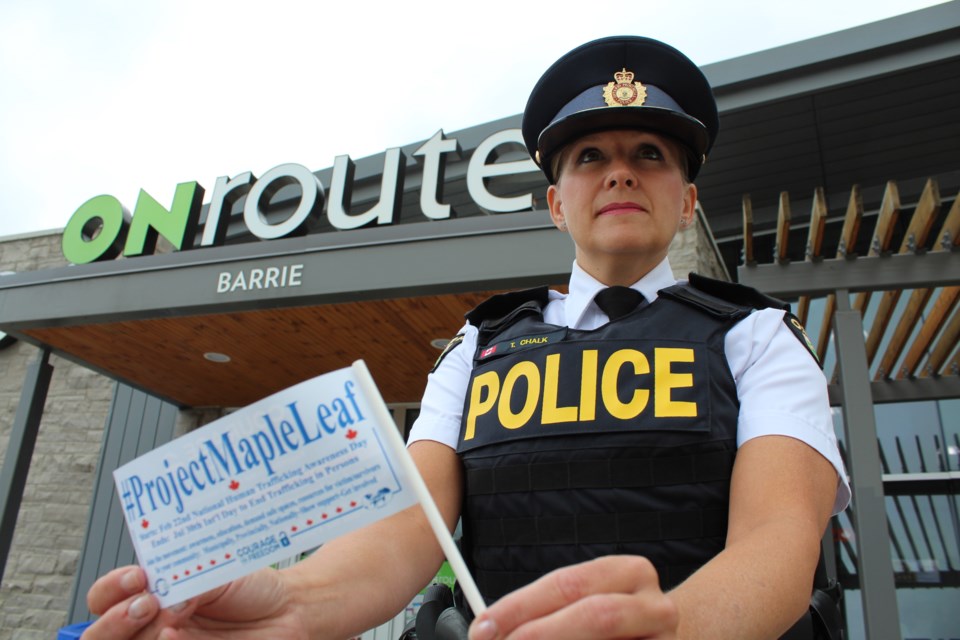Provincial highways are being used to move human-trafficking victims around Ontario and abroad, often in plain sight of millions of motorists.
The Barrie ONroute rest stop on Highway 400 near Essa Road was used as the backdrop today to get out a critical message, by teaching people how to spot possible cases of human trafficking. Officials are hoping the combination of transportation and technology could be a key element in the pushback.
The Project Maple Leaf campaign includes a short video, shown on video messaging boards at numerous ONroute locations, educating people with tips and some of the signs to look for in potential human-trafficking cases.
The video was shown in a two-minute loop at 20 locations across the province throughout July, with the potential for more than 16 million views. The clip shows girls having fun while travelling, with an appeal to find out how to spot human trafficking.
Kelly Franklin, chief executive director and founder of Courage for Freedom, which is the organization behind the campaign, said she wanted to take "the doom and gloom" out of the messaging and referred to the video as a "wake-up call."
"This is not the slutty girl in the gutter or in handcuffs," Franklin told BarrieToday during a telephone interview. "They just look like normal girls and boys, but you need to know what to look for."
Insp. Tina Chalk, with the OPP's counter-exploitation and missing persons section, said provincial highways are a critical link in the battle against human trafficking, where victims end up on the sex trade.
"It's absolutely important that we're here at the ONroutes today because these are the conduits to the highway," Chalk told BarrieToday. "Not always but very often, people are tranported (using the provincial highway system).
"They are taken from what we call their source location — so where they are located, lured from or roomed from — and then they are transported to their destination location," she added. "That's where the demand for sex actually happens and that's why the highways are so relevant."
Police hope rest stops such as ONroute locations can be a source of crucial information or tips.
"As you can see around us today, there are many people, many people with lots of instincts that can say to themselves, 'something is wrong with that picture'," Chalk said. "That's important for community members to help us and to be our eyes and ears."
Several police officers, politicians and members of various advocacy groups were on hand Tuesday morning to highlight what people can do to help in the fight against human trafficking. The event, which included representatives from numerous advocacy groups, was held in conjunction with the International Day to End Trafficking.
According to stats from Courage for Freedom, an organization based in Aylmer, Ont., more than 60 per cent of people trafficked in Canada have reported it started for them in Ontario.
"This community, unfortunately, is no stranger to the issue of human trafficking, both for sexual and for labour purposes," Barrie Mayor Jeff Lehman said during the news conference. "The rise of human trafficking and the ease with which traffickers are able to ensnare vulnerable members of our society, particularly young women, is distressing."
It will take a united effort between police, the public and women's organizations to combat the crisis, Lehman said.
"The only way we're going to save the victims, find the victims (and) help the victims is by working together as a community," he said.
Barrie-Innisfil MPP Andrea Khanjin said Attorney General Doug Downey, who is also the respresentative for Barrie-Springwater-Oro-Medonte, was unable to attend today's event, but "the cause was very near and dear to his heart."
"The fact that young girls are trafficked as young as 13 years old is unacceptable," said Khanjin, who added "Barrie has a very dark history" with human-trafficking cases in recent years.
"It takes every one of us to stand up and it takes a lot for these courageous women to come out, but it also takes strong men to stick up for them," she added, noting more roundtable discussions on the issue are also being planned.
Orillia Mayor Steve Clarke said the choice to use the ONroute locations for the news conference was a wise one.
"Traffickers have been here and those who are being trafficked have been here," he said. "It's our most vulnerable that are the ones who are targeted."
Members of the public are being asked to key a number into their phones in case they witness suspected cases of human trafficking. The number for the Canadian Centre to End Human Trafficking is 1-833-900-1010.
Chalk says there are many different traits to look for in possible cases of human trafficking, and there's not usually one thing that glaringly sticks out.
"It's a whole variety of things and we as humans have an instinct and will notice when something doesn't fit right," said the inspector, adding they are usually females under the age of 25, although there are males and people outside of that age group, too.
"If they aren't in control of the situation, or someone is with a person who is telling them what to do," she said of possible examples. "You can tell that there's a control issue there."
Today was the culmination of the ONroute portion of the campaign, which will now branch out into social media as well as public places such as malls and theatres. Next February, it's expected to go national.
For more information, click here.



